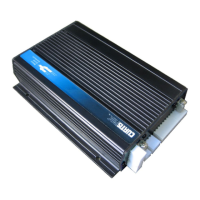VARIABLE TYPES & QUANTITIES
VCL provides dedicated space in which to store custom variables. There are four types of
variables, based on their type of storage:
• Volatile Memory (RAM)
• Automatic Non-Volatile memory (EEPROM)
• Non-Volatile Block Memory (EEPROM)
• Parameter Non-Volatile Memory (EEPROM)
Volatile Memory (RAM) variables are stored only while power is on; they are lost at power
down. This is the typical form of memory used to hold temporary calculations, counters and
other variable that are only needed while running. The generic VCL name for these variables are
User1 – 120. They can be initialized on power-up by explicit VCL assignments (i.e., User1 = 12)
otherwise they will be reset to a value of 0.
Automatic Non-Volatile memory (EEPROM) are labeled NVUser1–15 in VCL. These 15 variables
are stored cyclically while running and at power-down. They can be recalled by using the VCL
NVM_NVUser_Restore function. Thus, they are automatically saved and can then be recalled at
the next power-on cycle to restore their previous values. See the section on non-volatile memory
access in the VCL Common Functions manual for more information.
Non-Volatile Block Memory (EEPROM) are 38 blocks of 15 variables (total of 570 variables),
which are stored and recalled using the functions NVM_Block_Read and NVM_Block_Write.
The 38 blocks are called NVM3–NVM40. The read and write functions will retrieve and store
RAM (such as User20) variable(s) from and into the EEPROM blocks. See the section on non-
volatile memory access in the VCL Common Functions manual for more information.
Parameter Non-Volatile Memory (EEPROM) variables are a special type of EEPROM variable
that are only to be used to create OEM defined 1311 parameters. These 1311 parameters can be
defined as a 16-bit word by using the P_User variables or they can be defined as single bit by
using the P_UserBit variables. These value of these variables are modified and stored by using
the the 1311 or 1314 programmer interface (i.e., when a 1311 user changes a parameter setting
using the 1311). They can be read or written to in the VCL code. It is very important to note that
writing to parameters in VCL will not be stored in EEPROM or read by the 1311 or 1314
programmer. At the next power down, the data change made by VCL will be lost.
TYPE QUANTITY RANGE
RAM 120 variables User1 – User120
NVUser EEPROM 15 variables NVUser1 – NVUser15
Block EEPROM 38 blocks NVM3 – NVM40 (15 variables each)
Parameters EEPROM 100 16 bit variables
160 single bit variables
P_User1 – P_User100
P_UserBit1 – P_UserBit10
1310 Vehicle Control System Users Manual Release Rev B Page 26 of 51

